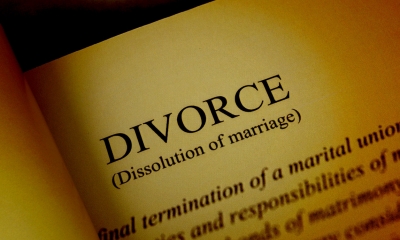
Some divorce legal terminology was simplified on 6 April 2022. We have included the current and past terminology where applicable.
Access
Also now called 'contact', although old term still commonly used. Usually refers to allowing a child to stay with the parent with whom they do not mostly live, but could relate to grandparents and others or contact via phone calls, emails and letters.
Acknowledgement of service
Form signed by the respondent and sent to the court to acknowledge receipt of a divorce petition (also called a matrimonial order application) confirming agreement to divorce or not.
Address for service
Postal address of husband, wife and any other parties to the proceedings.
Affidavit
Formal written statement sworn on oath so it can be used as evidence.
 How do I get divorced?
How do I get divorced?
Helping you take your next steps, from the UK's largest specialist family law firm (rated ‘Excellent’ by 94% of customers on Trustpilot).
Adultery
Sexual intercourse during the marriage between a spouse and someone of the opposite sex who is not their husband or wife. One of the five valid reasons for getting a divorce before the switch to ‘no-fault’ divorce on 6 April 2022.
Alimony
Term sometimes used to describe regular maintenance payments from one spouse to the other.
Ancillary relief
A legal term for financial proceedings or financial remedies.
Annulment
A way of ending a marriage (or a civil partnership) that is or has become legally invalid for particular reasons - for example, if one of the partners was under age.
Answer
Formal defence to a divorce petition/matrimonial order application, rebutting the evidence.
Applicant
Person applying to the court for a divorce. Previously called the petitioner.
Arbitration
Instead of going to court, the parties can choose an arbitrator to rule on some or all of the issues in dispute. The arbitrator's decision (called an award) is then made into a binding court order.
Cafcass
The Children and Family Court Advisory and Support Service, which represents children in divorce and separation cases, informing the court what the children's best interests would be, notably when child custody is disputed.
Cash equivalent value (CEV)
Value of the rights accrued within a pension scheme (previously called cash equivalent transfer value).
Child arrangements order
An order which details arrangements for a child, including where the child will live and how they spend their time with each parent.
Child Maintenance Service
A government agency that can help you work out and collect child maintenance payments if you are unable to agree things between yourselves. Replaces the Child Support Agency, which was fully wound down in 2017. Use the Child Maintenance Service on the GOV.UK website.
Child Support Agency
The agency that used to help parents agree child maintenance payments, now succeeded by the Child Maintenance Service.
Children and Family Reporter
An officer appointed by Cafcass to provide a welfare report on a child. The report includes the child's wishes and also a recommendation on what the officer thinks would be in the child's best interests.
Civil partnership
A legal relationship that can be registered by two people who are not related to each other. A civil partnership gives same-sex couples very similar treatment as to a heterosexual married couple in various legal matters, including relationship breakdown.
Clean break settlement
Once-and-for-all financial settlement that includes an agreement that the husband and wife (or civil partners) will make no further financial claims against each other. A schedule of child maintenance payments can be included.
Cohabiting/cohabitation
A couple living together in a committed personal relationship without being married or in a civil partnership.
Collaborative law
Collaborative approach to dealing with finances and childcare arrangements, etc. The couple and their lawyers pledge to work together to negotiate an agreement without going to court.
Common law marriage
When two people live together, as if they were married, but without having married or entered a civil partnership. This 'marriage' is a myth legally-speaking, as common law marriage is not a legally recognised status and common law spouses do not get automatic rights like couples who are married or in a civil partnership.
Consent order
Turns settlement terms agreed by the husband and wife (or civil partners) into a legally binding agreement.
Contact
Previously called access. Usually refers to allowing a child to stay with the parent with whom they do not mostly live, but could also cover arrangements with grandparents and others and contact via phone calls, emails and letters.
Costs order
The court can order one spouse to pay the other's legal costs. During a divorce, it is quite common for the respondent to contribute towards the applicant's costs.
Decree absolute
Now known simply as 'final order'. In the divorce process, the final order that dissolved a marriage.
Decree nisi
Now known simply as 'conditional order'. The initial divorce decree, which established the grounds for divorce but did not dissolve the marriage.
Directions order
Court order directing how the case will proceed (eg hearing timings and what evidence needs to be submitted).
Disclosure
Process of providing complete financial details about a person's capital, income, assets and liabilities. Can be voluntary or by court order. Usually done by filling in a Form E.
Dissolution
The term used for the ending of a civil partnership (equivalent to divorce in marriage).
District Judge
Sits in the County Court and deals with most matters relating to divorce cases.
Divorce petition
The term previously used for a divorce application. The document that started the divorce process.
Domicile
Country where a person has his/her permanent home or closest connection.
Equity in a property
Property net value after mortgages or other charges are paid.
FDA
First directions appointment - the first court appointment, where the judge considers what information is needed from both sides to progress the divorce settlement. Sometimes combined with the FDR (see below).
FDR
Financial dispute resolution hearing - the second court appointment, at which the judge tries to help both parties reach agreement.
Final hearing
If the FDR hearing doesn't result in agreement, a new judge hears both parties and any experts and then makes a binding court order.
Financial remedies
General term for possible financial orders the court can grant as part of the divorce settlement (eg a lump sum, property adjustment or pension sharing). Used to be called ancillary relief.
Form A
'Notice of an application for a financial order' form; starts off process of dealing with financial claims in a divorce.
Form E
Sets out a person's financial circumstances and details which orders are sought (see financial remedies).
Form G
Sent to the court before the FDA appointment, confirming whether the FDA and FDR hearings can be combined.
Forms H and H1
Submitted to the court before each court hearing; provides details of each party's costs and payments towards them.
Former matrimonial home
House in which the divorcing couple were living together before they separated. Often the biggest asset that has to be dealt with on divorce.
Grounds for divorce
Before 6 April 2022 and ‘no-fault’ divorce, these were the five valid reasons that could be used to show that a marriage had irretrievably broken down.
Joint tenancy
Common form of property joint ownership. If one party dies, the survivor will own the entire property. See also tenants in common.
Judicial separation
Alternative to divorce, usually used when religious reasons mean a couple does not wish to divorce. Formal separation sanctioned by the court that divides up money and property without terminating the marriage.
Lump sum order
Where the court orders one spouse to pay a sum or series of lump sums to the other spouse.
Maintenance
Regular payment by one spouse to another under a court order or following an agreement.
Maintenance pending suit (MPS)
Temporary maintenance for a spouse pending the completion of a divorce. Also called interim maintenance or maintenance pending outcome of proceedings.
Matrimonial home
House in which the divorcing couple were living together before they separated. Also known as the former matrimonial home.
Matrimonial order application
Previously called a divorce petition and now called a divorce application. The document that started the divorce proceedings, setting out the reason given for the divorce.
Mediation
Process in which trained independent mediators try to help a separating couple to agree arrangements regarding finances or children as an alternative to having a court-imposed decision. Visit the Family Mediation Council website.
Mediation information and assessment meeting (MIAM)
Couples are expected to attend a MIAM meeting to ensure they understand and have considered the mediation process before commencing any court proceedings about children, finance or dissolving the marriage.
Non-molestation order
Court order that usually prohibits one person from using or threatening violence or intimidating, harassing or pestering another person.
Occupation order
Court ordered exclusion of a person from the family home (or part of it) for a period of time. Sometimes a power of arrest is attached, allowing the police to arrest anyone disobeying the order.
Order
Direction by the court that is legally binding and enforceable.
Pension sharing order
Where the court transfers part of one spouse's pension entitlement to the other, creating a separate pension for the other.
Permission to remove
Application to the court for permission to remove a child permanently from England and Wales. Previously called leave to remove.
Petition
Term previously used for the divorce application that started the divorce proceedings.
Petitioner
Term previously used for the spouse who applied for a divorce, now called the applicant.
Post-nuptial agreement
Same as a pre-nuptial agreement, but the contract is agreed and signed at any time after the marriage ceremony. A well-written contract agreed by both parties can determine the outcome of a divorce.
Pre-nuptial agreement
Contract that is signed before marriage, usually to agree how property and assets will be split between the spouses in the event of separation or divorce. Also known as a pre-marital agreement or contract. A well-written contract agreed by both parties can determine the outcome of a divorce.
Process server
Someone employed to deliver court papers to the named recipient. To prove that the papers have been served, the process server will normally swear an affidavit which will be sent to the court.
Prohibited steps order
Prohibits something being done to a child (eg changing a child's surname or taking the child abroad).
Property adjustment order
Where the court deals with property owned by the spouses (eg requiring a family home to be transferred into the sole name of one of the spouses or sold).
Questionnaire
List of questions asking for further details about a person's financial circumstances, usually made in response to gaps or omissions in someone's Form E.
Relevant child
Child of the marriage, either aged under 16 at the time of the conditional order or aged between 16 and 18 and in full-time education or training. A disabled and dependent child of the marriage of any age will always be considered a relevant child.
Residence order
Term previously used for a court order specifying who a child will live with. Now replaced by child arrangements orders.
Respondent
Person who receives a divorce application or other application to court.
Separation agreement
Document that sets out the arrangements between a couple after separation.
Service
Formal process by which court documents are sent to and received by the party to whom they are addressed.
Specific issue order
Determines a specific issue relating to a child (eg naming the school that a child is to attend).
Statement of truth
Short formal statement confirming contents of a written document are true.
Tenants in common
Way of owning property jointly. If one of the owners dies, their share is dealt with under the terms of their will. See also joint tenancy.
Without prejudice
Correspondence or documents marked "without prejudice" cannot be shown to the court (unless there is a without prejudice hearing). The objective is to encourage discussions about settlement.



